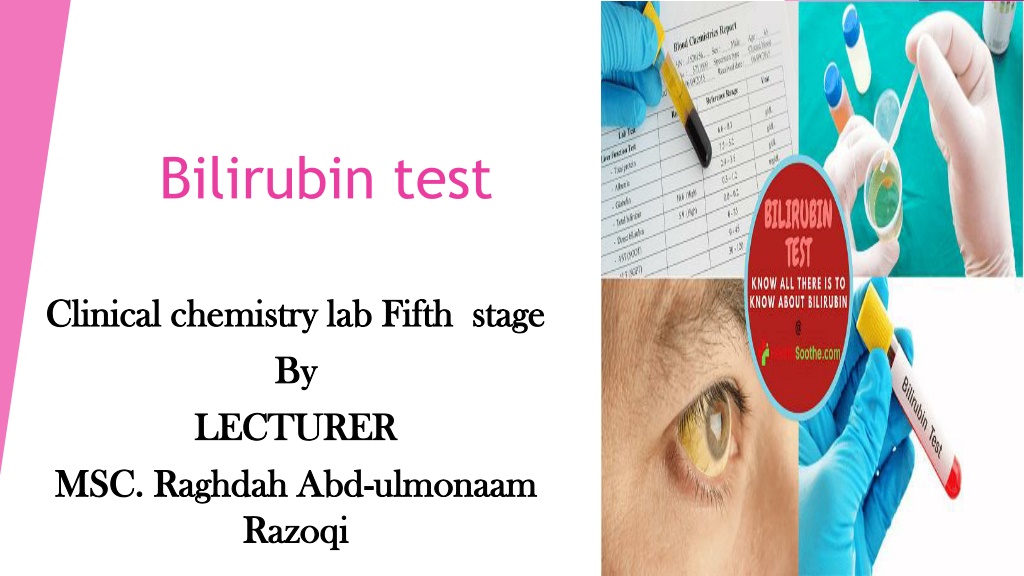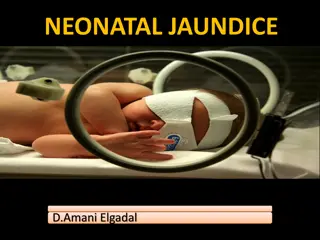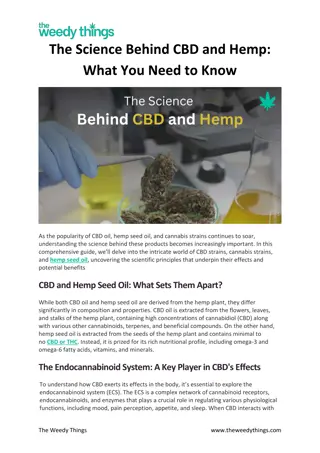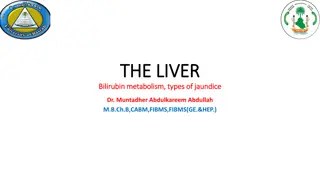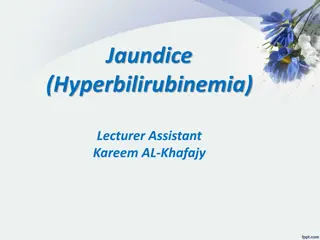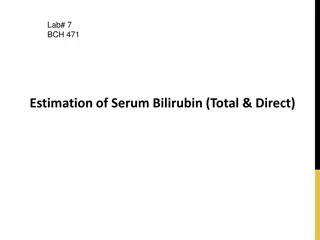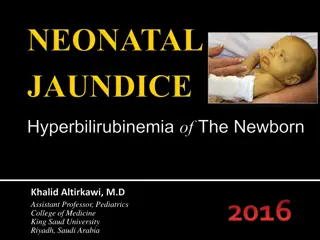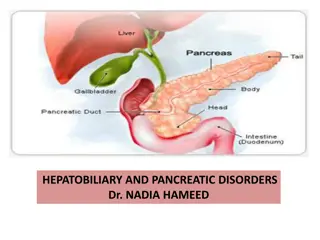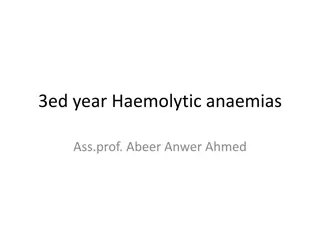Understanding Bilirubin: What You Need to Know
Bilirubin is a yellowish substance formed during the breakdown of red blood cells, traveling through the liver before excretion. High levels indicate hyperbilirubinemia, often signaling underlying health issues. It's a common occurrence in newborns as well. The compound plays a crucial role in the body's waste clearance process, with elevated levels suggesting potential diseases. Learn about bilirubin, its production, breakdown, and importance in health assessments.
Download Presentation

Please find below an Image/Link to download the presentation.
The content on the website is provided AS IS for your information and personal use only. It may not be sold, licensed, or shared on other websites without obtaining consent from the author. Download presentation by click this link. If you encounter any issues during the download, it is possible that the publisher has removed the file from their server.
E N D
Presentation Transcript
Bilirubin test Clinical chemistry lab Fifth stage Clinical chemistry lab Fifth stage By By LECTURER LECTURER MSC. Raghdah Abd MSC. Raghdah Abd- -ulmonaam Razoqi Razoqi ulmonaam
What is bilirubin? Bilirubin is a yellowish substance in your blood. It forms after red blood cells break down, and it travels through your liver, gallbladder, and digestive tract before being excreted. The condition of having high bilirubin levels is called hyperbilirubinemia. It s usually a sign of an underlying condition, so it s important to follow up with a doctor if test results show you have high bilirubin. It s also a common temporary condition in newborns.
is a red-orange compound that occurs in the normal catabolic pathway that breaks down heme in vertebrates. This catabolism is a necessary process in the body's clearance of waste products that arise from the destruction of aged or abnormal red blood cells. In the first step of bilirubin synthesis, the heme molecule is stripped from the hemoglobin molecule. Heme then passes through various processes of porphyrin catabolism, which varies according to the region of the body in which the breakdown occurs. For example, the molecules excreted in the urine differ from those in the feces.The production of biliverdin from heme is the first major step in the catabolic pathway, after which the enzyme biliverdin reductase performs the second step, producing bilirubin from biliverdin .Ultimately, bilirubin is broken down within the body, and its metabolites excreted through bile and urine; elevated levels may indicate certain diseases. It is responsible for the yellow color of healing bruises and the yellow discoloration in jaundice. Its breakdown products, such as stercobilin, cause the brown color of feces. A different breakdown product, urobilin, is the main component of the straw-yellow color in urine.
Blood tests Bilirubin is degraded by light. Blood collection tubes containing blood or (especially) serum to be used in bilirubin assays should be protected from illumination. For adults, blood is typically collected by needle from a vein in the arm. In newborns, blood is often collected from a heel stick, a technique that uses a small, sharp blade to cut the skin on the infant's heel and collect a few drops of blood into a small tube. Non-invasive technology is available in some health care facilities that will measure bilirubin by using an instrument placed on the skin (transcutaneous bilirubin meter).
Abb. Name(s) Water-soluble Reaction "Conjugated bilirubin" Yes (bound to glucuronic acid) Reacts quickly when dyes (diazo reagent) are added to the blood specimen to produce azobilirubin "Direct bilirubin" "BC" Reacts more slowly, still produces azobilirubin, Ethanol makes all bilirubin react promptly, then: indirect bilirubin = total bilirubin direct bilirubin "Unconjugated bilirubin" "BU" No
What causes high bilirubin? 1. Gallstones Gallstones happen when substances like cholesterol or bilirubin harden in gallbladder. gallbladder is responsible for storing bile, a digestive fluid that helps break down fats before they enter intestines. 2. Gilbert s syndrome Gilbert s syndrome is a genetic liver condition that causes your liver to not process bilirubin properly. This causes the bilirubin to build up in bloodstream. 3. Liver dysfunction Any condition that affects the function of liver can cause bilirubin to build up in your blood. This is a result of your liver losing its ability to remove and process bilirubin from bloodstream. Several things can affect the function of your liver, including: a. cirrhosis b. liver cancer c. autoimmune disorders involving the liver, such as autoimmune hepatitis.
5.Bile duct inflammation these ducts become inflamed or blocked, bile can t be properly drained. This can lead to an increased level of bilirubin. Symptoms of bile duct inflammation may include: pale stools dark urine Jaundice 6.Hemolytic anemia Hemolytic anemia happens when blood cells break down too quickly in your bloodstream. It s sometimes passed down genetically, but autoimmune conditions, an enlarged spleen, or an infection can also cause it.
Bilirubin levels in newborns Many babies have high bilirubin a few days after birth, causing a condition called newborn jaundice. This is a temporary condition that usually resolves on its own within a few weeks. It happens because newborns have more red blood cells and break them down more quickly, but their livers are not developed enough to keep up. Prior to being born, the pregnant person s liver helps with this task. A newborn s liver is only about 1 percent Trusted Source as active as an adult s. In most cases, higher bilirubin levels will lead to jaundice between 1 and 3 days after birth. Bilirubin levels can peak as high as 18 mg/dL Trusted Source in the fourth or fifth day, and the jaundice typically clears up within 2 weeks as the liver matures. Feeding 8 to 12 times per day helps to promote regular bowel movements, which help to remove bilirubin from the body.
If jaundice occurs within the first 24 hours after birth, or if bilirubin levels are especially high or don t begin to fall on their own, doctors may intervene with treatments such as: phototherapy intravenous immunoglobulin treatment exchange transfusion
How to know of high-level Vomiting or nausea Weakness Fatigue Shortened breathe Swollen abdominal (liver and spleen) Jaundice
Principle of S bilirubin Bilirubin + Diazotized sulphanilic acid Azo bilirubin compounds
Wave length 546 nm for Total bilirubin test Addition sequence Total bilirubin reagent Total nitrite reagent Sample B T 1.0 ml 1.0 ml 50 L 100 L 100 L mix well and incubate at 25 room T. for 10 min measure the abs. of the test samples calculation= (ABS. T. ABS. B.) * 13
Wave length 546 nm for Direct bilirubin test Addition sequence Direct bilirubin reagent Direct nitrite reagent Sample B T 1.0 ml 1.0 ml 50 L 100 L 100 L mix well and incubate at 25 room T. for 10 min measure the abs. of the test samples calculation= (ABS. T. ABS. B.) * 13
Normal Value T.S.B. =low than 1.0 mg/ dL Normal Value Direct = low than 0.2 mg/dL
